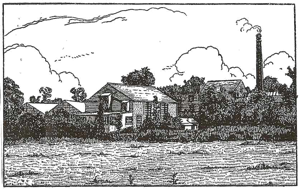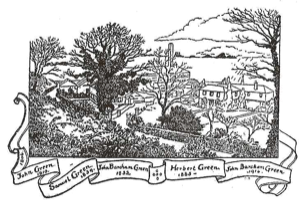Perhaps the greatest economic contribution to the hamlet has been that played by the paper mills. Paying wages that were higher than those that could be obtained from the limited work on the local farms, it drew its labour force mainly from Tuckenhay, Cornworthy, Dittisham, and Ashprington. Nowadays it draws from as far afield as Totnes and Dartmouth providing transport to and from.
Mr. Shorter gives the dates for the mills as:
1829 - today
1832 - 1860
The first mill is easy to find, the second poses something of a mystery.
Whites Devon 1850 records that "Ashprington includes part of Tuckenhay where there is a large paper-mill, corn mill ...". Under Cornworthy, we also find "includes Tuckenhay where there are quays on the river Harbourn and paper and corn mills". The Directory of Devonshire 1857 contains an entry under Ashprington as follows: - "There are some large paper mills at Tuckenhay, belonging to R. Turner & sons, employing about 100 hands". In White's Devon of 1890 we find the name of Turner linked with the name of Symons to form the entry, this time under Cornworthy of: "Turner, Symons & Co paper manufacturers at Tuckenhay Mill" and a further entry "a paper mill employing upwards of 100 hands". Entries such as these might well have led to the supposition that there were paper mills on the Ashprington side as well as the Cornworthy side of the river Wash. All the old maps I have seen have the words "Tuckenhay Paper Mill, or Mills" written on the Ashprington side but show the buildings on the Cornworthy side. The Title Map of 1843 makes no mention of the papermill.
Reference: The Story of Handmade Paper (1924)

Eynsford Paper Mill, Kent
There are a number of stone walls to fields and orchards on the Ashprington side of the river. These include Springfield, the adjoining meadow and the small orchard and gardens on the opposite side of the road. A study of a picture (pre-1920) of Bridge Terrace shows a disused section of wall extending up into Springfield. This wall does not enclose anything at all and has since disappeared. The mound of stone walling used as hedgerow appears to indicate at least a building falling into disuse, from which the stone was cannibalized. Perhaps this was the second paper mill, or the old ropeworks could also have been the second mill?
At all events there can be little doubt that Tuckenhay profited by having its fulling mill or mills falling into disuse just at the time when the demand for paper was being felt. It had the abundance of river water for power and really good spring water for the manufacturing process. The conversion from wool appears to have taken place about 1830. The parish records of Cornworthy record the name of Stephen Spry, papermaker, in 1830. One imagines that, at first, the real craftsmen to operate the final stages would have been imported. The woollen labourers providing the working force needed to prepare the basic raw materials of rags.
These basic raw materials would have been available from the large population of Devon and have been supplemented by imports. Shipping records at Dartmouth show the import of 'fine white or linen rags'. Though by 7 April 1860 the shortage of rags was giving concern. An article appeared, in the Totnes Weekly Times of that date which, while being mainly concerned with the effects of the paper duty controvery, exhorts householders to keep rag bags. Ideally they should keep three; one for woollens, one cottons and the last for printed paper.
Reference: The Story of Handmade Paper (1924)

Hayle Paper Mill, Kent